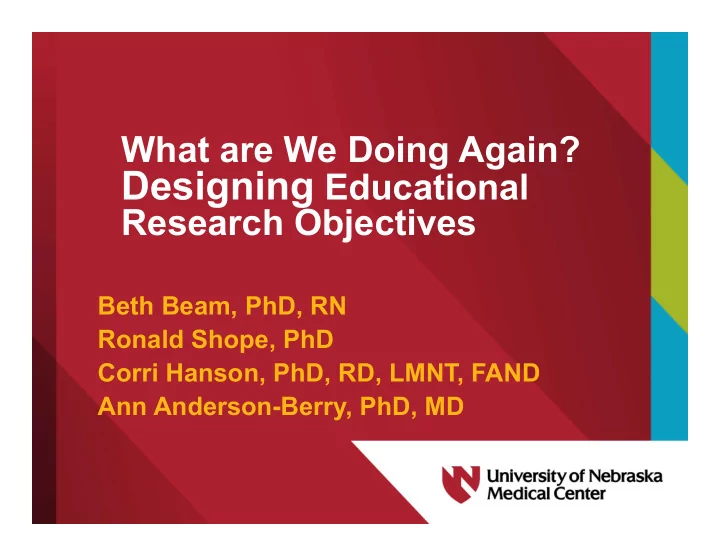

What are We Doing Again? Designing Educational Research Objectives Beth Beam, PhD, RN Ronald Shope, PhD Corri Hanson, PhD, RD, LMNT, FAND Ann Anderson-Berry, PhD, MD
Key Ideas • Constructing aims and objectives for educational research projects • Using a research design template • Linking education research objectives to research in your area of interest • Involving students in this process • The role education research projects play in developing your academic career
Constructing Education Research Aims and Objectives
Purpose Statements, Research Aim, and Research Hypotheses, • Research Aim (Purpose): a declarative statement that advances the overall direction or focus for the study. • Research Objectives: statements that narrow the purpose statement to specific questions that researchers seek to answer in their study. • Research Hypotheses: Declarative statements in quantitative research in which the investigator makes a prediction or conjecture about the outcomes relationship.
Quantitative Aim Script Example “The purpose (or Aim) of this study is to test _______ (the theory) by comparing _______(group 1) with _______ (group 2) in terms of ________ (dependent variable) for _________ (participants) at ___________ (the research site.)” * From Creswell, J. 2015). Educational research planning, conducting and evaluating quantitative and qualitative research (Fifth Edition). Upper Saddle River, NJ: Pearson. p. 123.
Quantitative research questions • Descriptive “How frequently do ______ (participants) _______ (variable) at _____ (research site)?” • Relationships How does _______ (independent variable) relate to _________ (dependent variable) for _______(participants) at _____ (research site)?” • Comparison “How does ______ (group1) differ from _______ (group 2) in terms of ________ (dependent variable) for _______ (participants) at _____ (research site)?” From Creswell, J. 2015). Educational research planning, conducting and evaluating quantitative and qualitative research (Fifth Edition). Upper Saddle River, NJ: Pearson. p. 124.
Writing Research Hypothesis: Null Hypothesis • Null Hypothesis “There is no significant difference between ____(independent variable, group 1) and ____(independent variable, group2) in terms of ______ (dependent variable) for _____ (participants) at ________ (research site).” • Directional Research Hypothesis “_______ (group1, independent variable) at _______ (research site) will have _____ (higher or lower or greater or lesser) scores on (dependent variable) than (group 2 of independent variable).” • Non-Directional Research Hypothesis There will be a difference between “_______ (group1, independent variable) at _______ (research site) and (group 2 of independent variable) at _______ (research site). From Creswell, J. 2015). Educational research planning, conducting and evaluating quantitative and qualitative research (Fifth Edition). Upper Saddle River, NJ: Pearson. p. 125-126.
Writing Qualitative Purpose statements The purpose of this Qualitative Study will be to ________________ (understand; describe; develop; discover) the ________________(Central Phenomenon) for _____________(participants) at (the site). At this stage of the research, the ________________(Central Phenomenon) will be generally defined as __________________ (a general definition of the central concept) Based on Creswell, J. 2018. Qualitative inquiry and research design choosing among the five approaches. Thousand Oaks, CA: Sage. P. 132.
Example Purpose Statement Script (Convergent Design) • This mixed methods study will The intent address [overall content aim]. A convergent parallel mixed methods The design design will be used, and it is a type of design in which qualitative and quantitative data are collected in parallel, analyzed separately, and then merged. In this study, [quantitative data] will be used to test The quantitative the theory of [theory name] that purpose predicts that [independent variables] statement will [positively, negatively] influence... • Taken from Creswell, J. and Plano Clark, V. 2018. Designing and conducting mixed methods research. Thousand Oaks, CA : Sage 155.
Example Purpose Statement Script (cont.) • ...the [dependent variables] for The qualitative [participants] at [the site]. The [type of purpose qualitative data] will explore [the central statement phenomenon] for [participants] at [the site]. The reason for collecting both quantitative and qualitative data is to [the The reason for reason for mixing]. mixing From Creswell, J. and Plano Clark, V. 2018. Designing and conducting mixed methods research. Thousand Oaks, CA : Sage 155.
Writing a mixed methods purpose statement
Research Design Template
Steps in the Research Process • Determine a Working Title for the Project • Describe the Background for your Study • Describe the Problem or Issue you wish to Study • Write a Study Aim or Purpose Statement
Steps in the Research Process (Continued) • Determine your Research Approach – Quantitative – Qualitative – Mixed Methods • Determine your Research Questions
Steps in the Research Process (Continued) • Determine your Research Design – Test-Retest – Scores over time – Case Study • Determine how you will analyze Your Data • Determine how you will disseminate Your results
Linking Education Objectives to Your Existing Research
Identifying Education Research Topics • Does your area of study indicate a knowledge deficit in your population? • Is there a need for learning about a procedure or therapy for patients or health professions students? • Satisfaction with a learning modality (not the best) • Effectiveness – how to measure?
It could happen to you…
Involving students in your research • Process of research development • IRB application • Development of eLearning • Data collection • Data analysis • Manuscript writing
What are We Doing Again? Designing Educational Research Objectives Beth Beam, PhD, RN Ronald Shope, PhD Corri Hanson, PhD, RD, LMNT, FAND Ann Anderson-Berry, PhD, MD
Recommend
More recommend